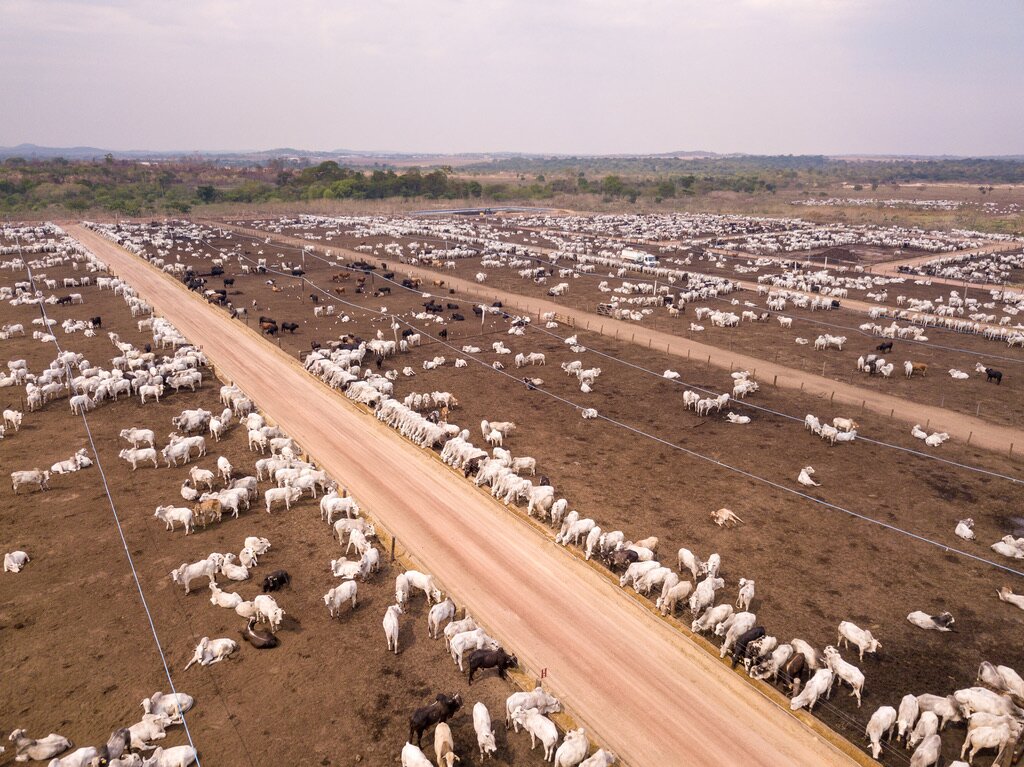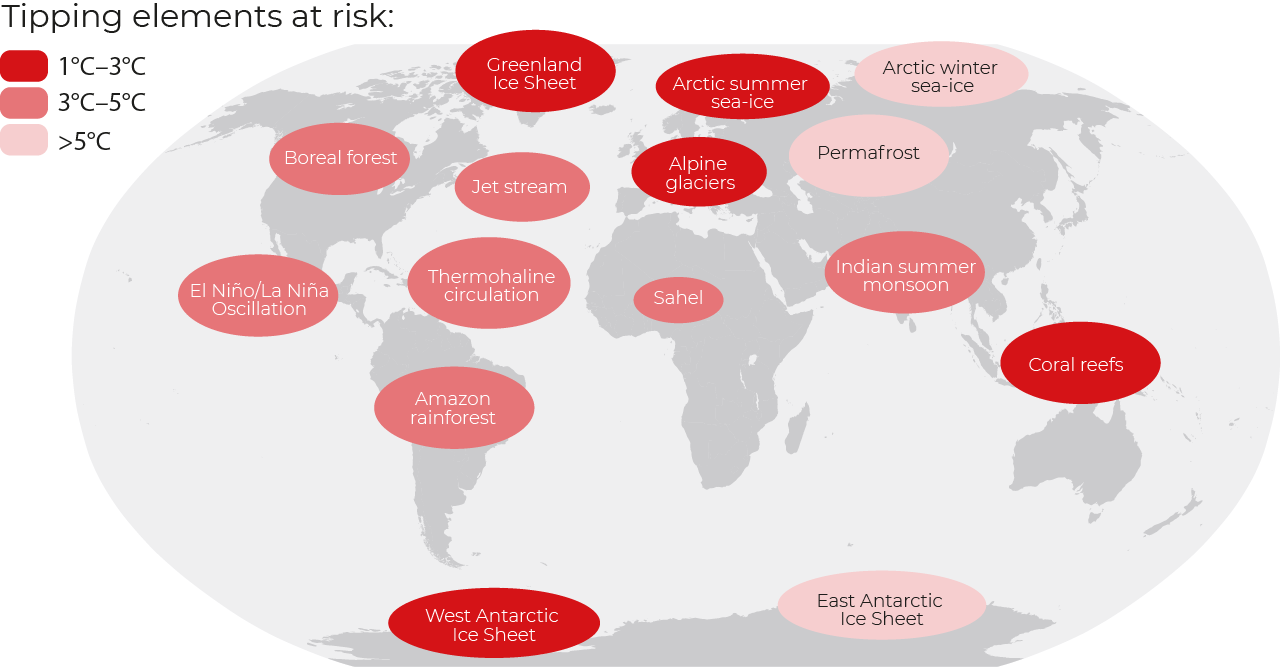The food system – A bittersweet tale of progress turned climate and human disaster

We’re currently experiencing the most rapid global warming in thousands of years. The latest IPCC report, released earlier this month, paints a somber picture of what many are facing and what awaits if we fail to act in the next couple of years. An “atlas of suffering,” as UN General Secretary António Guterres calls it. Inaction could indeed close the small window of opportunity we have for adaptation and make food security a luxury reserved for the richest few.
Raging wildfires, rising sea levels, punishing droughts, and devastating storms are becoming all too frequent as global temperatures increase. Despite most nations’ pledges to reduce greenhouse gas emissions, we’re still moving toward a rise of around 3°C by 2100. This goes beyond the 2°C goal negotiated in the 2015 Paris Agreement and the 1.5°C safety mark set by the IPCC. It’s also above anything our planet has experienced in the past three million years.
We are thus on a fast track to unknown planetary conditions and near-certain starvation for the most vulnerable among us. Accounting for the global population’s estimated growth from eight to ten billion by 2050, the difference between 1.5°C and 3°C of warming could mean a fifty-fold increase in the number of people affected by hunger.
Already today, extreme weather – caused by climate change – is the main culprit of agricultural loss. Soils are degrading, freshwater supplies are drying out, and yields are plummeting. The food system, including agriculture, is not only a victim of global warming, it is also the single largest greenhouse gas emitter. Pushing it toward a sustainable, resilient future requires nothing less than a revolution across its value chain.
Avoiding eating our way to the last supper
As things stand now, the world’s food system could get in the way of meeting the 1.5°C target. It contributes nearly 35% of annual greenhouse gas emissions, around 40% of which originates from production. And a 2018 study showed that by 2050, its environmental effects could further increase significantly.
But not all foods are made equal. There’s a dramatic emissions imbalance between plant- and animal-based food sources. The latter contributes close to 60% of food production emissions, despite providing only 37% of our protein and a mere 18% of our calories.

Reducing the impact of red meat, in particular, is an acute challenge as one kilo of beef generates the equivalent of 60 kilos of carbon dioxide (CO2e). In contrast, the same amount of fruits and vegetables emits less than one kilo CO2e.
If eating patterns continue on their current paths, we will need to increase crop production by 60% before 2050. We could, however, save one gigaton CO2e if half the world’s population shifted to a plant-based diet. Changes to agricultural management practices could deliver another gigaton CO2e.
To avoid eating our way to the last supper, we must also ensure that as little as possible of our painstakingly produced food is squandered. Because halving our total food waste and loss can reduce emissions by an additional gigaton CO2e.
How come food is so intrinsically linked to the climate?
A stable climate laid the foundation for agriculture
Over the past three million years, planet Earth has self-regulated within -6°C below and +2° above the 14°C average observed during the pre-industrial era. However, for the past 12,000 years, and up until the Industrial Revolution, global average temperatures didn’t waver more than 0.5°C. CO2 concentrations in the atmosphere remained steady too: between 250ppm and 270ppm.
This period of relative climate stability, known as the Holocene, laid the foundation for sedentary agriculture. That it sprouted in up to nine geographically separate areas around the same time, while Homo sapiens had already roamed the Earth for around 150,000 years, underlines how important the Holocene climate conditions were for the emergence of farming. Why? The explanation is quite simple! To grow, plants absorb CO2 - together with sun and chlorophyll. But too much of the good stuff hinders their growth. As does too little.
Therefore, exceeding 2°C will put pressure on agricultural yields worldwide and reduce the nutritional quality of what we eat. Both pose health risks at best and survival risks at worst. It will also trigger irreversible shifts and potentially force the planet toward “Hothouse Earth” - an extreme state last experienced some 56 million years ago when global mean temperatures were 5 – 8°C higher than today.
The Anthropocene: tractors in the fast lane
Human activities began to fundamentally transform the planet already during the Holocene. By domesticating livestock, tilling land, and clear-cutting forests for cultivation, humans altered natural landscapes and drove the extinction of megafaunas.
But it was the Industrial Revolution that sparked the relationship between human prosperity and mounting pressure on the Earth systems and the climate. We started tapping into millions of years of energy stored in coal to feed machinery that, in turn, generated greenhouse gases. CO2, aerosols, methane, ozone, and nitrous oxides are among the most powerful. Their concentration in the atmosphere regulates how much of the sun’s rays reach the earth’s surface, determining the warmth of the earth. Today, although the fossil fuel, forestry, and transport industry are also to blame, two-thirds of the greenhouse gases created by humans come from the food system.

The Industrial Revolution revamped agricultural practices. It allowed for the systemization of deforestation, the engineering of landscapes, the capture of nitrogen from the air to produce synthetic fertilizers, etc. All of which paved the way for intensive farming.
By the middle of the 20th century, all that progress had triggered a radical “Green Revolution.” Granted, standardized techniques and high-yielding crops made it possible to increase production and reduce hunger. Still, it also plundered the planet’s resources, polluting air and waterways and cementing our climate interference.
Scientists agree that these abrupt changes define the beginning of a new geological era: the Anthropocene. An epoch in which humans have become a global force for geological change. In the face of frightening transformations, they are determining thresholds at which this accumulated pressure will exceed our planet’s ability to absorb it.
Approaching the tipping points
Since the early 2000s, a set of processes, patterns, and ecosystems has been identified as tipping elements. Driven beyond critical thresholds, these factors could trigger a domino effect of climate calamities. And the risk increases with rising global temperatures. At 1.5°C higher than pre-industrial levels, we risk activating up to five of the tipping elements. Which could make pushing the “stop” button on climate change almost impossible. And there are already signs pointing to certain critical elements being on the verge of collapse. As is the case for ice sheets.

Ice sheets play an essential role in the earth systems. They regulate the temperature of the water and air around them, driving circulation patterns that determine weather conditions across the globe.
With average temperatures in the Arctic warming almost twice as fast as the rest of the planet, the Greenland ice sheet, for example, has thinned considerably in recent years. As its surface sinks, it comes into contact with lower, warmer layers of air, leading to further melting. The irreversible loss of the Greenland ice sheet could be reached if the global temperature rises by slightly less than 2°C.
This would inject massive amounts of fresh water into the ocean, possibly leading to a complete shutdown of the Atlantic Meridional Ocean Circulation – one of the most powerful ocean circulation patterns. It’s essential for temperature regulation and the redistribution of nutrients, salt, and other gases across all oceans. At 2°C, regions relying on snowmelt could experience a 20% decline in water availability for agriculture after 2050.
Transgressing these individual tipping points would wreak havoc on our Earth system. But the interconnectedness of tipping elements suggests an even greater risk of permanently leaving the Holocene climate conditions if one or more of them were triggered. At that point, cascading effects could thrust us on a path toward a Hothouse Earth.
Taking the reins of the 21st century
Each degree of global warming will put pressure on agricultural yields worldwide. On land, global maize yields could drop by up to 7.4% with each additional degree. The picture looks fairly grim for wheat, rice, and soybeans too. Their yields could drop by 3% to 6%. Fruits and vegetables will likely not fare much better. At sea, since oceans absorb the majority of excess CO2, fish are dying, and, by extension, our food supply is diminishing.
Heat stress will also lead to reduced food quality, thereby increasing food waste. Making matters worse, ozone concentration and soil salinization can reduce the nutritional quality of what we eat, posing additional risks to human health. These losses will vary greatly from region to region, but already vulnerable areas will endure the worst of it.
On a societal level, compound risks are significant. Since heat stress reduces productivity, either farmers’ livelihood will shrink, or food prices will go up. Both scenarios can, in turn, have local and international economic effects.
But as much as our food is a big part of the climate problem, it has to become a bigger part of the solution. And there is good news. Science suggests that the food system has the potential to deliver 4 Gt CO2-equivalents per year. That's around one-quarter of the required emissions reductions by 2050.
Transforming the food sector from a carbon source to a carbon sink – while at the same time feeding a growing world population – will be an existential challenge over the next three decades. But it is now that the level of ambition must increase. Get inspired and check out these outstanding projects doing just that.
This article is based on the research report The Foul Breath of Climate Change published in October 2020. The report was commissioned by the Food Planet Prize and authored by Dr. Johan Rockström and Dr. Lila Warszawski.